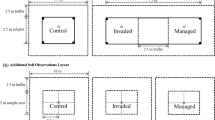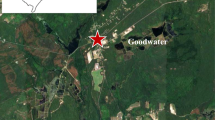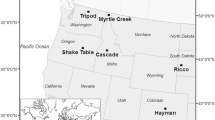Abstract
We conducted field surveys and laboratory analyses to test the effects of soil characteristics in habitat mitigation sites and natural sites on the growth and condition of blue elderberry (Sambucus mexicana), which is the sole host plant for the federally threatened Valley elderberry longhorn beetle (Desmocerus californicus dimorphus). Thirty mitigation and 16 natural sites were selected throughout the range of the beetle. We found that although plant relative growth rates were comparable between mitigation sites and a natural site, mitigation sites contained substantially less soil nutrients than mitigation sites. Within mitigation sites, elderberry health and growth were positively correlated with the amount of total nitrogen in soils and less strongly with other soil nutrients and soil moisture. Analyses demonstrated reductions in the relative growth rate of elderberry as mitigation sites aged, and that soil nutrients and soil moisture became depleted over time. For mitigation sites, it took approximately seven years to develop basal stem diameters that have been linked to successful beetle colonization. Mitigation sites have smaller shrubs than natural sites and growth slows as mitigation sites age, thus delaying convergence of conditions between natural and mitigation sites. Analyses of soil particle size and whether sites were within the 100-year floodplain (as an indicator of riparian conditions) were inconclusive. We recommend investigating fertilizing and optimum planting densities for elderberry at restoration and mitigation sites, as well as increasing the duration of irrigation and monitoring.



Similar content being viewed by others
References
Allen-Wardell G, Bernhardt P, Bitner R, Burquez A, Buchmann S, Cane J, Cox PA, Dalton V, Feinsinger P, Ingram M, Inouye D, Jones CE, Kennedy K, Kevan P, Koopowitz H, Medellin R, Medellin-Morales S, Nabhan GP (1998) The potential consequences of pollinator declines on the conservation of biodiversity and stability of food crop yields. Conservation Biology 12:8–17
Alpert P, Griggs FT, Peterson DR (1999) Riparian forest restoration along large rivers: initial results from the Sacramento River Project. Restoration Ecology 7:360–368
Baker WL, Walford GM (1995) Multiple stable states and models of riparian vegetation succession on the Animas River, Colorado. Annals of the Association of American Geographers 85:320–338
Barr CB (1991) The distribution, habitat and status of the Valley elderberry longhorn beetle, Desmocerus californicus dimorphus Fisher (Insecta: Coleoptera: Cerambycidae). U.S. Fish and Wildlife Service, Sacramento, CA
Bradshaw AD (1997) The importance of soil ecology in restoration science. Pages 33–64. In: Urbanska KM, Webb NR, Edwards PJ (eds). Restoration Ecology and Sustainable Development. Cambridge University Press, Cambridge, UK
Collinge SK, Holyoak M, Barr C, Marty JT (2001). Riparian habitat fragmentation and population persistence of the threatened Valley longhorn beetle in central California. Biological Conservation 100:103–113
Desert Research Institute, Western Climate Center. Local climate data summaries by station identity. Downloaded on December 31, 2006 from http://www.wrcc.dri.edu/summary/Climsmcca.html
Ehrenfeld JG, Toth LA (1997) Restoration ecology and the ecosystem perspective. Restoration Ecology 5:307–317
Federal Register (1980) Listing the Valley elderberry longhorn beetle as a threatened species with critical habitat. Federal Register 45:155
Fisher RA (1921) Some remarks on the methods formulated in a recent article on the quantitative analysis of plant growth. Annals of Applied Biology 7:367–372
Florsheim JL, Mount JF (2002) Restoration of floodplain topography by sand-spay complex formation in response to intentional levee breaches, Lower Cosumnes River, California. Geomorphology 44:67–94
Federal Emergency Management Agency (1995) Managing flood development in approximate zone “A” areas: A guide for developing and maintaining developing base (100 year) flood elevations. FEMA publication #265
Goodwin CN, Hawkins CP, Kershner JL (1997) Riparian restoration in the Western United States: Overview and perspective. Restoration Ecology 5:4–14
Hey D L, Phillippi NS (1999) A case for wetland restoration. John Wiley and Sons, Inc., New York, NY
Hilderbrand RH, Watts AC, Randle AM (2005) The myths of restoration ecology. Ecology and Society 10:19–29
Holyoak M, Koch M The effects of site conditions and mitigation practices on success of establishing the Valley elderberry longhorn beetle and its host plant blue elderberry. Environmental Management (In press)
Holyoak, M, Talley TS, Hogle SE How effective are current mitigation practices for imperiled species? A case study of the threatened Valley elderberry longhorn beetle. Biological Conservation (In press)
Hunter JC, Willett KB, McCoy MC, Quinn JF, Keller KE (1999) Prospects for preservation and restoration of riparian forests in the Sacramento Valley, California, USA. Environmental Management 24:65–75
Kalliola R, Puhakka M (1988) River dynamics and vegetation mosaicism: a case study of the River Kamajohka, northernmost Finland. Journal of Biogeography 15:703–719
Li FR, Zhang H, Zhao L, Shirato Y, Wang X (2003) Pedoecological effects of sand-fixing poplar (Populus simonii Carr) forest in a desertified sandy land of Inner Mongolia, China. Plant and Soil 256:431–442
Marston RA, Girel J, Pautou G, Piegay H, Bravard JP, Arneson C (1995) Channel metamorphosis, floodplain disturbance, and vegetation development: Ain River, France. Geomorphology 13:121–131
Mcbride JR, Strahan J (1984) Establishment and survival of woody riparian species on gravel bars of an intermittent stream. American Midland Naturalist 112:235–245
Morrison ML, Smallwood SK, Hall LS (2003) Creating habitat through plant relocation, lessons from the Valley elderberry longhorn beetle mitigation. Ecological Restoration 21:95–100
Neal PR (1998) Pollinator Restoration. Trends in Ecology & Evolution 13:132–133
Osterkamp WR, Hupp CR (1984) Geomorphic and vegetative characteristics along three northern Virginia streams. Geological Society of America Bulletin 95:1093–1101
Richards JH, Chirman DB (1994) Establishment of understory woody species of California Central Valley riparian habitats: Nutrient dynamics and flooding tolerance. Technical Completion Report UCAL-WRC-W-786
Singer MJ, Munns DN (1996) Soils: An Introduction, 3rd Ed. Prentice-Hall, Inc, Upper Saddle River, NJ
Smith F (1980) A short review of the status of riparian forest in California. In: Sands A (eds) Riparian Forests in California: Their Ecology and Conservatio. Division of Agricultural Sciences, University of California, Berkeley, CA
Talley TS (2007) Which spatial heterogeneity framework? Consequences for conclusions about patchy population distributions. Ecology 88:1476–1489
Talley TS, Fleishman E, Holyoak M, Murphy DD, Ballard A (2007) Rethinking a rare-species conservation strategy in an urban landscape: The case of the Valley elderberry longhorn beetle. Biological Conservation 135:21–32
Talley TS, Wright D, Holyoak M (2006) Assistance with the 5-Year Review of the Valley elderberry longhorn beetle (Desmocerus californicus dimorphus). United States Fish and Wildlife Service, Sacramento, California. Available at http://www.fws.gov/sacramento/es/documents/VELB_5yr_review_Talley_etal.pdf
USFWS (United States Fish, Wildlife Service) (1988) Conservation Guidelines for the Valley Elderberry Longhorn Beetle. US FWS, Sacramento, CA
USFWS (1999) Conservation Guidelines for the Valley Elderberry Longhorn Beetle. US FWS, Sacramento, CA
USWFS, National Marine Fisheries Service (1998) Section 7 Consultation Handbook. USFWS Washington, DC
Vaghti MG, Holyoak M, Williams A, Talley TS, Fremier AK, Greco SE (In review) The ecology and restoration of Sambucus mexicana (blue elderberry) in human-altered riparian systems, with implications for threatened Desmocerus californicus dimorphus (Valley elderberry longhorn beetle). Environmental Management
Ware GH, Penfound WT (1949) The vegetation of the lower levels of the floodplain of the South Canadian River in Central Oklahoma. Ecology 30:478–484
Young TP, Petersen DA, Clary JJ (2005) The ecology of restoration: historical links, emerging issues and unexplored realms. Ecology Letters 8:662–673
Zar JH (1996) Biostatistical Analysis. Prentice Hall, Inc. Upper Saddle River, NJ
Acknowledgments
We thank Rachel Zisook, Lauren Valverde, Peter Nilsson, Henning Gertz, and Karen Adler for assistance with field work. Assistance with mitigation site selection and access, and annual monitoring reports were provided by Kelly Kawsuniak, Sharon Stacey, Terry Marshal, Margaret Lawrence, and Christina Macias at California Department of Transportation (CalTrans). We thank the following for help with access to sites and/or reports: Jane Caputo, Nathan Higgins, and Hilary Dustin (Sequoia Riverlands Trust); Phil Deffenbaugh, Sidney Jones, and Larry Baker (U.S. Army Corps of Engineers); Andrew Fulks and J.P. Marie (Putah Creek Stream Keepers); Jones and Stokes Inc.; Annalena Bronson and Dwaine Cornett (Department of Water Resources); John Fitzpatrick (SunCal Companies); Sara Egan (E-Corp); Dave Camden (Greenhorn Creek Resort); Matt Gause (Wildlands, Inc); Susan P. Jones and Charlene Steeman (USFWS Sacramento Field Office). For GIS data we thank Diane Pierzinski (CalTrans) and Mary Meade (Office of Homeland Security). We thank Theresa S. Talley and John Callaway for their guidance and support. Funding for this project was provided by CalTrans contract 43A0067 Task Order 52.
Author information
Authors and Affiliations
Corresponding author
Koch-Munz and Holyoak: Appendix 1
Koch-Munz and Holyoak: Appendix 1
See Tables A1 and A2 that follow.
Rights and permissions
About this article
Cite this article
Koch-Munz, M., Holyoak, M. An Evaluation of the Effects of Soil Characteristics on Mitigation and Restoration Involving Blue Elderberry, Sambucus mexicana . Environmental Management 42, 49–65 (2008). https://doi.org/10.1007/s00267-008-9074-x
Received:
Revised:
Accepted:
Published:
Issue Date:
DOI: https://doi.org/10.1007/s00267-008-9074-x




